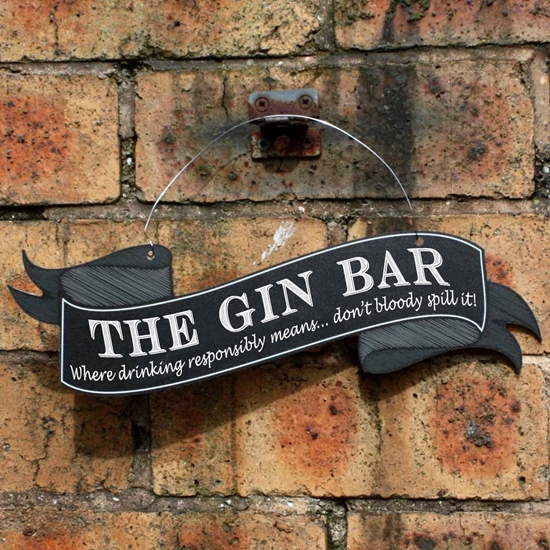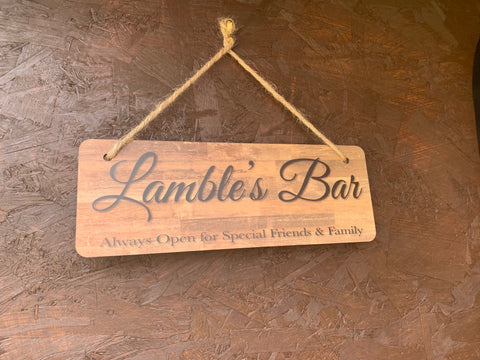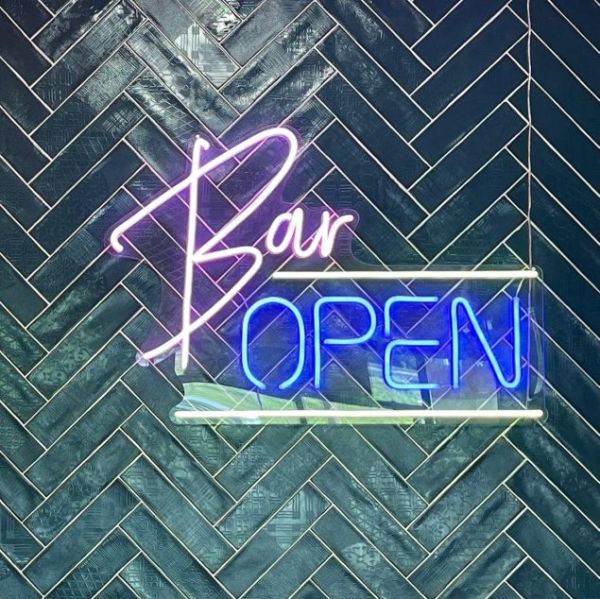Best Ideas For Selecting Man Cave Signs
Wiki Article
How Do Bar Signs Differ From Each Other In Relation To Their Intended Purpose?
There are a variety of uses of bar signposts. Here are a few of the primary functions of bar signs and the ways they differ. Branding
Purpose : To reinforce and establish the bar's brand identity.
Features: Display the bar's name, logo and signature colors. The idea is to make it a standout element that is a reflection of the overall theme of the bar and atmosphere.
Customized metal signs bearing the bar's name or a neon sign with its logo are two examples.
2. Information
Use: Provide vital information to patrons about the bar.
Features: Clear, easy-to read text that communicates vital information such as hours of operation and Wi-Fi passwords as well as home rules, or bathroom areas.
Examples: Signs at the entrance indicating hours of service or signs that indicate restrooms.
3. It's a decorative object.
Goal: To improve the appearance and ambience of the bar.
Features: They are often artistic or thematic and add to the aesthetics of the bar as a whole. The bar may or may not have any written text.
Examples include: old beer advertisements, funny signs, or even quirky art.
4. Promotional Materials
The goal of the campaign is To advertise certain products, specials or special events.
Features: Designs with eye-catching graphics that showcase special offers or upcoming events. They can include elements that are temporary or re-usable elements.
Examples include chalkboards featuring daily deals, banners advertising happy hour offers and posters that promote future events.
5. Directional
Use to direct customers to the correct bar.
Features: Clear arrows and instructions for customers to navigate the bar area, for instance finding bathrooms, exits or other locations within the bar.
Examples: Directional arrows within various seating locations.
6. Regulatory/Compliance
The purpose is to comply with legal requirements and to ensure safety.
Specifications: A sign that meets legal requirements. For instance, it can indicate the smoking zone and occupancy limit or emergency escapes.
Examplesinclude "No Smoking" signs or occupancy limit warnings emergency exit signs.
7. Interactive
The goal is to engage customers and provide an engaging experience.
Features: The elements that encourage patron involvement. Examples are write-on surfaces as well as digital interaction.
Signs with QR Codes connecting to digital menus (or social media) or chalkboards that allow customer messages are a few examples.
8. Thematic
The goal is to create a specific atmosphere or theme.
Specifications: Signs that are aligned with the style of the bar, which contributes to a positive overall ambience.
Examples: Pirate-themed signage in a bar with a maritime theme; rustic wooden signs for an establishment themed on the countryside.
9. Menu
The goal of this menu is to display the beverages available in the bar.
Features Description: Lists food and drinks clearly, typically with prices. Can be static, or can change.
Examples include rotating digital menus that rotate on screens, or on wall-mounted menus.
Each bar sign is created to serve a particular purpose. The design of each sign is determined by the function it plays in the bar. When they understand the different types, bar owners will be able decide and install signs in a manner that improves patrons' experience as well as meets their operational requirements. Take a look at the top rated hanging pub signs advice for website examples including modern pub sign, pub signs made, pub signs personalised, pub signs personalised, sign for garden bar, bar signs for home bar, pub signs for garden, garden bar sign personalised, bar signs for garden, design a pub sign and more.

How Do Bar Signs Get Mounted And Installed Different?
Bar signs differ in terms of mounting and installation based on their type weight, size, location and purpose. This article will provide a more detailed look at bar sign mounting and installation methods: Wall-Mounted Signs
Fixed directly to walls.
Methods:
Anchors and screws are used to secure heavier signs (metal and wood).
Adhesive Strips : Can be used to create small signs (foam boards and acrylics) and temporary installations.
Brackets: Used for signs that need to be able to protrude from the wall for greater visibility.
Uses: Indoor decor, menu boards, directional signs.
Benefits: A secure and versatile display.
Disadvantages: Can be damaging to walls, hard to reposition.
2. Hanging signs
Characteristics Suspended overhangs or ceilings.
Methods:
Chains: durable and adjustable great for signs with heavy weights.
Cables: Contemporary designs typically use cables for their sleeker appearance.
Rods: Provide a rigid support structure.
Uses: Ceiling decor, directional signs, overhead promotional signs.
Advantages: Highly visible, makes use of vertical space and is decorative.
Negatives
3. Signs for Freestanding Places
The main characteristic is that it does not attach to any other structure. Supported by a base or stand.
Methods:
A-Frames are portable and foldable. They are typically employed to advertise along the street.
Pedestal Stands: Stable base, ideal for indoor use.
Panel and post: Typical for large permanent signs.
Uses: Outdoor advertising, indoor directional signs, promotional displays.
Benefits: Easy to move, mobile, and adaptable.
The downside is that it is heavy. It also requires plenty of area for floor.
4. Window Signs
Specifications: It is attached directly to windows.
Methods:
Suction Cups are great for signs with light, since they are simple to remove and put in.
Adhesive Glass: It can be directly applied to the surface of the glass. Perfect for decals, graphics as well as other graphics.
Static cling is reusable permanent adhesive that is easy to remove or apply.
Uses: Marketing and branding, operating hours.
Benefits: Maximizes window space, is very visible from the outside.
Cons: Window size. The effect of sunlight can be a problem. the sun.
5. Signs with Edge and Backlit Lighting
Signs with lighting are a must-have.
Methods:
Wall-mounted electrical connections (Requires secured mounting and electrical hook-ups):
Suspended using Power Cables Combines hanging technique and integrated lighting.
Uses include: high-visibility branding for menu boards as well as decorative elements.
Benefits: Better visibility, attractive illumination.
Disadvantages: Requires electrical work and more complicated installation.
6. Temporary & Portable Signs
Specifications: Designed to be easy installation and removal.
Methods:
Pop-Up Stands are lightweight and compact.
Banner Stands: Roll-up or retractable designs.
Examples include occasions, promotions and seasonal decorations.
Advantages: Easy to transport easy to set up and transport.
Inconsistency: Not as durable or solid.
7. Magnetic Signs
Magnetic force used for attachment.
Methods:
Magnetic Strips: Adhered on the reverse of the sign.
Magnetic Boards (Signs) can be attached to any metal surface.
Uses For: Temporary notices, menu boards that can be altered.
Advantages: Easy to change and no permanent fixtures needed.
Advantages only available for magnetic surfaces. It is less secure.
8. Projection Signs
Features The ability to project images or text by using light.
Methods:
Mounted projectors can be mounted securely to walls or ceilings.
Portable projectors are placed on stands, or other surfaces.
Displays with dynamic content are used for promotions, events and other promotional activities.
Benefits There is no physical signage needed, and content can be easily altered.
Negatives
Take into account when mounting and assembling
Size and Weight
The heavy signs (Heavyweight) These signs require more durable mounting solutions, such as screws and bolts.
Light Signs can be made by using less complicated methods, such as adhesive strips or suction cups.
Durability
Make sure you use permanent signs that are more robust.
Temporary signs: Choose methods that are simple to remove and reposition.
Location
Indoor: Greater flexibility with methods and materials and less concern with weather resistance.
Outdoor: Requires weather resistant materials and secure mounting in order to stand up to elements.
Aesthetics
Concealed mounting: This choice provides a cleaner look by concealing the hardware.
Hardware that is decorative: It enhances the look of a sign.
Accessibility
Simple access to changes: This is important for menu boards, signs and other signage which require regular changes.
Security: Signs must not be easily taken or altered with.
These elements will assist bar owners choose the right method of installation and mounting which are the most appropriate for their bar. They can ensure that their signs are safe, visible and in accordance with their aesthetics and needs. Read the top rated cocktail bar sign tips for site advice including bar signs for garden, large pub sign, pub signs made, outdoor home bar signs, bar signs for garden, bar sign outdoor, personalised beer sign, personalised garden bar signs, personalised cocktail sign, garden pub signs and more.

What's The Difference In Budgetary Signs For Bars?
The cost of bar signage will depend on the material used, design complexity, modification, and installation requirements. What are the differences between bar signs? Material Cost
Low-Cost Materials: Signs constructed out of materials such as foam board, vinyl decals or simple acrylic are typically more affordable.
Signs made of expensive materials: Due to the price of materials as well as craftsmanship, signs made of premium materials like wood, metal or even custom-made glass can be more expensive.
2. Design Complexity
Simple Designs: Signs that feature simple designs, simple text and simple graphics are usually less expensive.
Signs that have intricate graphic designs or bespoke typography (e.g. neon, LED) require more time to design and require additional skills.
3. Customization
Standard Options: Templates that are pre-designed or signs that are available off the shelf tend to be more cost-effective than custom-designed signage.
Customized Features Custom logos, colors and finishes are available at an additional cost. These features offer a unique chance to promote the bar.
4. Size and Scale
Small-Scale Signs : Tabletop signs decals, tabletop signs, or wall-mounted signage are usually cost-effective due to the lesser manufacturing and material costs.
Costs for large-scale signage: Larger signage such as marquees for outdoor use or illuminated display are more costly because of the extra work and materials required.
5. Lighting
Signs that are not illuminated: Signs that don't have lighting are less expensive since they need fewer components and electrical work.
Illuminated signs: the cost of LED, neon or backlit signage is increased due to the extra wires, materials and energy required by lighting.
6. Installation
DIY Installation. Signs installed by staff or bar owners are less expensive than signs that require professional installation.
Professional Installation Signs that are huge or complicated may require professional installation. While this may raise the price of the sign, it also ensures security and a proper installation.
7. Quantity
Large orders can qualify for discounts on volume or per unit cost in comparison to single purchases.
Single Orders: Ordering single signs or pieces may cost more, due to manufacturing and installation costs.
8. Costs for maintenance and long-term costs
Low-Maintenance Signs require minimal maintenance and have a long life may offer cost savings in the long run because they reduce the cost of maintenance and replacement.
Signs that require high-maintenance maintenance: Signs with intricate designs, fragile materials, or specialized maintenance requirements may be more expensive to maintain and require ongoing repairs and maintenance.
9. Budget Allocation
Allocated budgets: By setting the budget in a specific way, bar owners will be able decide how much they will spend on their signage on elements like visibility, branding and durability.
Cost-Benefit Analysis: By analyzing the investment return of various signage options, bar owners can make a more informed decision about how to invest their money.
Financing Options
Upfront Payment - Paying upfront is a efficient option than a loan or installment plan because it will eliminate financing fees and interest.
Financing Plan: Certain sign companies offer financing options or payment plans to aid in spreading out the costs of their signage. This can make higher-end options available to bar owners without a large upfront investment.
Consider these factors while making your choices within your budget when choosing signage that enhances customer experience, communicates your brand identity and adds value to your establishment. Follow the top rated twofb.com bar signs for more advice including personalised home pub sign, personalised pub signs for garden, bar sign design, personalised pub, personalised pub signs for garden, home pub signs, bar wall signs, garden bar signs, gin bar sign, hanging home bar signs and more.
